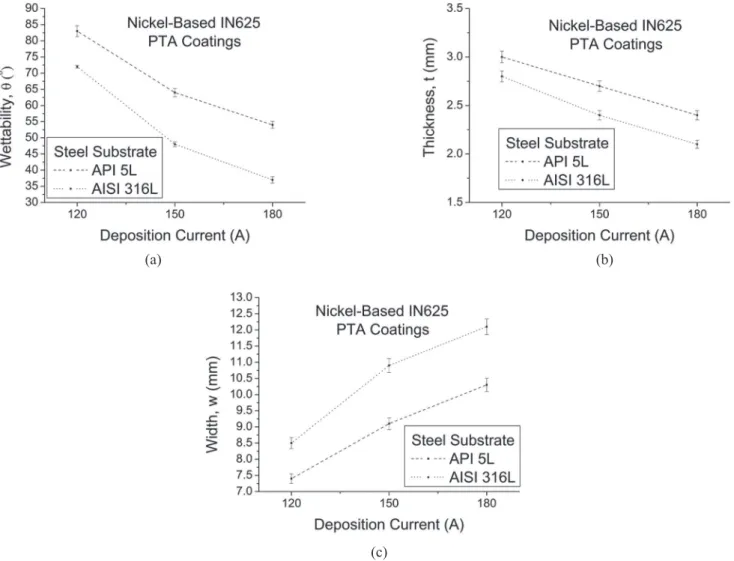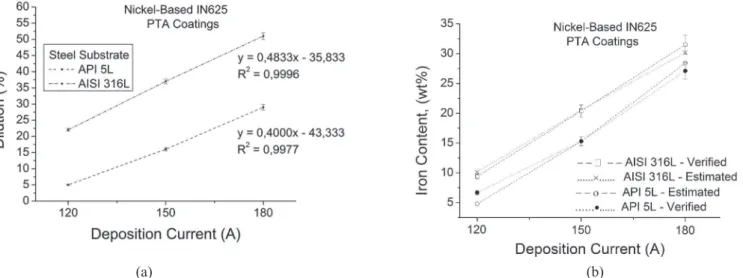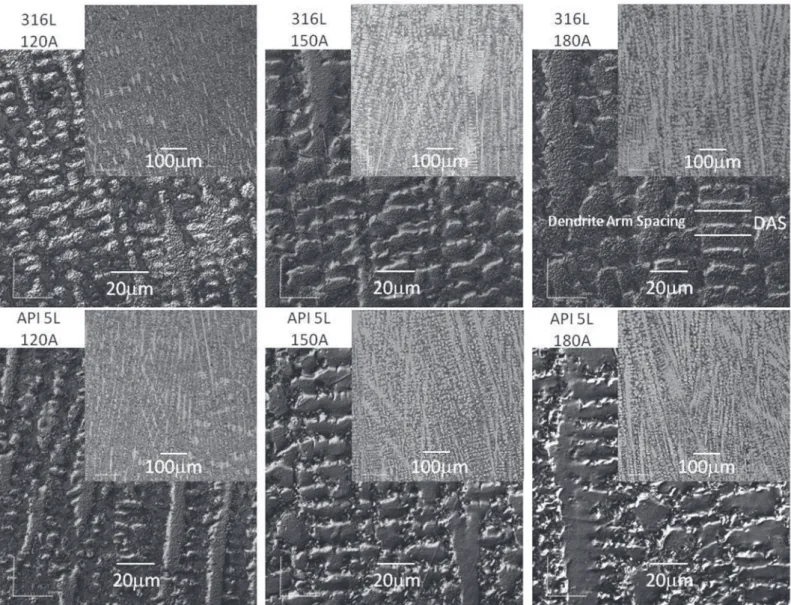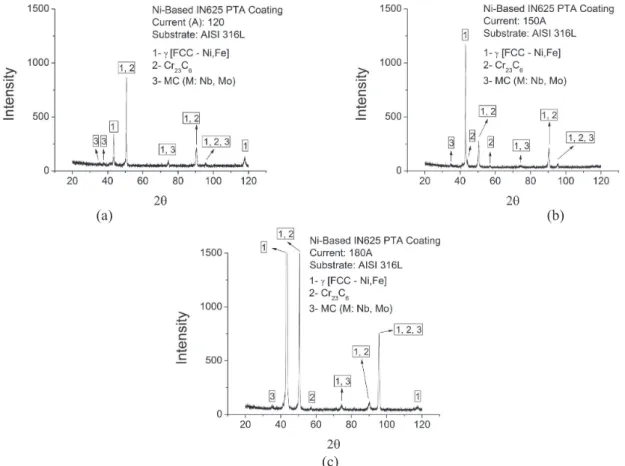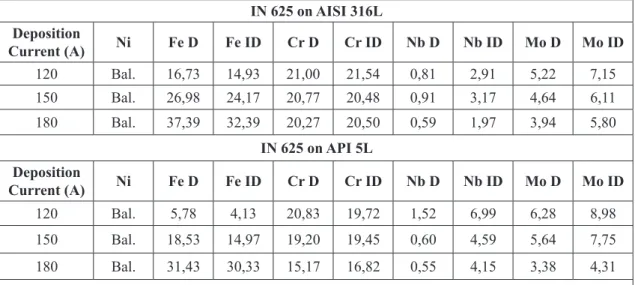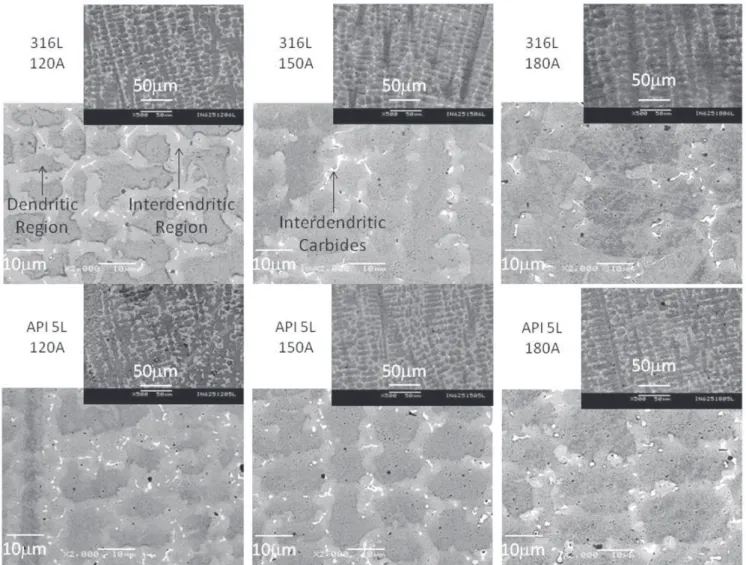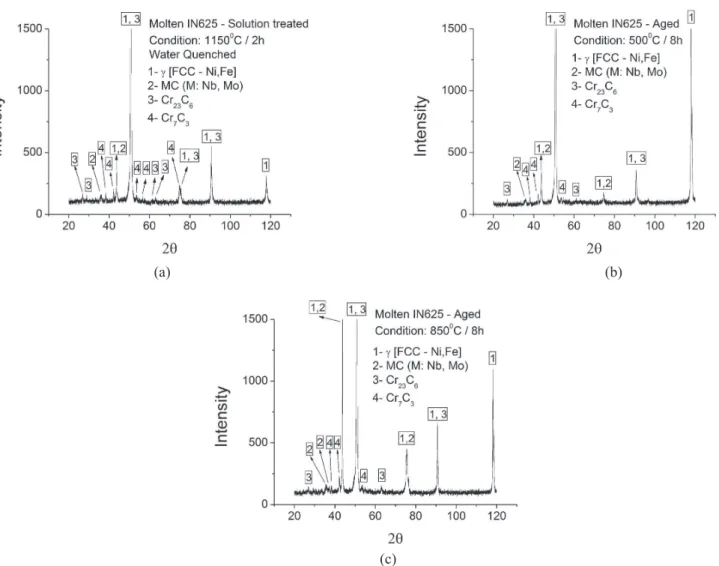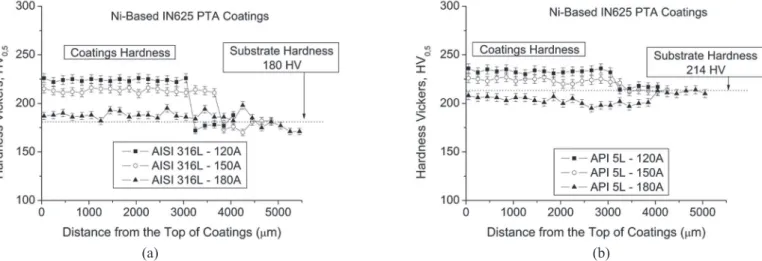Recebido em 18/03/2014, texto inal em29/04/2014. DOI: 10.1590/0104-9224/SI1902.05
(Impacto da diluição na Microestrutura e Propriedades de Revestimentos da Liga de Níquel 625)
Tiago Jose Antoszczyszyn,1 Rodrigo Metz Gabriel Paes,1Ana Soia Clímaco Monteiro de Oliveira2and Adriano Scheid 2 1PGMec, UFPR, tiago_tja@yahoo.com.br, rodrigo.metz@ufpr.br
2 Mechanical Engineering Department, Universidade Federal do Paraná, Curitiba, Paraná, Brazil, , sofmat@ufpr.br,scheid@ufpr.br
Abstract
Nickel-based alloy IN 625 is used to protect components of aircrafts, power generation and oil reinery due to an association of toughness and high corrosion resistance. These properties are associated with the chemical composition and microstructure of coatings which depend on the processing parameters and the composition of the component being protected. This paper assessed impact of dilution on the microstructure and properties of the Ni alloy IN 625 deposited by Plasma Transferred Arc (PTA) on two substrates: carbon steel API 5L and stainless steel AISI 316L. Differences due to the interaction with the substrate were maximized analyzing single layer coatings, processed with three deposition current: 120, 150 and 180 A. Correlation with a cast Nickel-based alloy sample contributed to assess the impact of dilution on coatings. Dilution was determined by the area ratio and Vickers hardness measured on the transverse section of coatings. Scanning electron and Laser confocal microscopy and X-ray diffraction analysis were carried out to characterize the microstructure. Results indicated the increasing dilution with the deposition current was deeply inluenced by the substrate. Dilution ranging from 5 to 29% was measured on coatings processed on the API5L steel and from 22 to 51% on the low thermal conductivity AISI316L steel substrate. Differences on the microstructure and properties of coatings can be associated with the interaction with each substrate. Higher fraction of carbides account for the higher coating hardness when processing on API 5L whereas the low thermal conductivity of AISI 316L and the higher Fe content in solid solution contributed to the lower hardness of coatings.
Keywords: Plasma Transferred Arc (PTA), Nickel-based Alloy, IN625 alloy, Relation Microstructure-Properties
Resumo
Liga de Níquel do tipo IN 625 é usada para proteger componentes de turbinas aeronáuticas ou de geração de energia e de reinarias de petróleo, especialmente devido a uma associação de tenacidade e elevada resistência à corrosão. Estas propriedades são associadas com a composição química e com a microestrutura dos revestimentos que dependem dos parâmetros de processo e da composição do componente a ser revestido. Este artigo avaliou o impacto da diluição sobre a microestrutura e propriedades da liga de Níquel IN 625 depositada por Plasma com Arco Transferido (PTA) sobre dois substratos: aço carbono API 5L e aço inoxidável AISI 316L. Diferenças relacionadas à interação com o substrato foram maximizadas pela análise de revestimentos com cordão único, processados com três correntes de deposição: 120, 150 e 180 A. Correlação com a liga de Níquel fundida contribuiu para avaliar o impacto da diluição aos substratos. A diluição foi determinada pela razão de áreas e a dureza Vickers medida na seção transversal dos revestimentos. Microscopia Eletrônica de Varredura, Laser Confocal e difração de raios-X foram realizados para caracterizar a microestrutura. Os resultados indicaram que o aumento da diluição com o aumento da corrente de deposição foi fortemente inluenciado pelo substrato. Diluição entre 5 e 29% foi encontrada para os revestimentos processados sobre aço API 5L e entre 22 e 51% para o substrato de aço inoxidável com baixa condutividade térmica AISI 316L.Diferenças na microestrutura e propriedades dos revestimentos podem ser associados com a interação a cada substrato. A maior fração de carbonetos promoveu maior dureza nos revestimentos processados sobre API 5L, enquanto a baixa condutividade térmica do aço AISI 316L e o maior teor de ferro em solução sólida nos revestimentos contribuiu para a menor dureza observada nestes revestimentos.
Palavras-chave: Plasma com Arco Transferido (PTA) Liga de Níquel, Liga 625, Relação Microestrutura-Propriedades
1. Introduction
proved to be and eficient procedure to enhance service life of components. The processing of coatings by Plasma Transferred Arc (PTA) to protect components with high performance alloys is a competitive procedure [1].
Nickel-based alloys are extensively used in different industries, due to an association of high strength and excellent corrosion resistance. Engineering components can be protected from the aggressive operating conditions experienced in a wide range of harsh environments, as found in the chemical, petrochemical, nuclear reactors, food processing devices and steelmaking facilities [2-8].
The performance of a hardfaced coating is strongly inluenced by their microstructure, which is determined by the chemical composition and solidiication rate of coatings. Therefore, the effect of processing parameters and the interaction with the substrate (component to be protected) should be controlled to maximize results. The latter is commonly minimized depositing multilayer coatings but, unless the effects of this interaction are understood for each pair of materials, it can result on higher costs due to the unnecessary use of the high performance coating alloy. It is of great relevance to identify the consequences on microstructure and properties of coatings of the interaction between a deposited alloy and each substrate steel as pointed out in the study of Yaedu et al. when evaluating dilution of a Co-based alloy coatings. Each pair of materials will exhibit unique interaction features that can be more or less minimized by the multilayer procedure and consequently affect performance differently [9].
The performance of Ni based alloys is associated with the face-centered cubic (FCC) structure of the g nickel matrix that can be strengthened by solid-solution hardening, carbide precipitation and / or precipitation hardening of intermetallics. Iron, chromium, molybdenum, tungsten, titanium and aluminum are solid-solution hardeners in nickel. For high temperature applications, large solid solution elements as molybdenum and tungsten are preferred, because of their low diffusion coeficients in the austenitic matrix. Nickel is not a carbide former and carbon can react to form MC, M6C, M7C3 or M23C6 carbides, depending on the temperature, though the M23C6 is the most important and inluent on mechanical properties at room temperature. The precipitation of gamma prime g’(Ni3(Al, Ti)) in a high nickel content matrix also provides strengthening to the material, mainly after heat treatment [2].
In the IN 625 alloy Nb is added to the nickel-chromium-molybdenum alloy system, a solid solution strengthener, and, together with the molybdenum, they provide high strength without requiring heat treatment. Niobium also can form the g’’ precipitate Ni3Nb body-centered tetragonal (BCT) or Ni3Nb orthorhombic. Precipitation of BCT g’’ intermetallic can provide signiicant strengthening while Ni3Nb orthorhombic induces
hardness decrease. 15% or more chromium content is added to the alloy to provide both oxidation and carburization resistance at temperatures exceeding 7600C [2].
The NiCrMo alloy system can be used to fabricate components that meet a wide range of service requirements. Moreover, these alloys exhibit a good weldability facilitating hardfacing procedures. However, the inluence of steel substrate
on the microstructure and properties of coatings can affect the performance under harsh environments. This work assessed the impact of the interaction between IN 625 alloy and the substrate on the microstructure and characteristics of coatings processed by Plasma Transferred Arc on two different substrates: a corrosion resistant AISI 316L stainless steel and a low carbon API 5L steel.
2. Materials and Methods
The atomized Nickel-based IN 625 alloy, grain size within the range 90-150 μm was processed on two different substrates, with the chemical composition shown in Table 1. Single layer Plasma Transferred Arc (PTA) hardfacing with 100 mm length on AISI 316L stainless steel, 12,5 mm thick plate, and API 5L carbon steel, 10,0mm thick plate, was carried out with the processing parameters reported in Table 2. The IN 625 alloy was also processed on a cooled Cu mold (5x5mm cross section) in order to obtain a zero dilution sample. Zero dilution samples were solution treated at 11500C for 2h and water quenched.
Aging treatment at 500 0C and 850 0C for 8h was carried out
to determine the hardness range and phases of a supersaturated solid solution and with different precipitate distribution.
The weld track extremities were 20 mm discarted and the microstructure was analyzed by scanning electron and laser confocal microscopy on the transverse cross section of deposits. Dendrite Arm Spacing (DAS) was measured by linear interception method using microscopy analysis as an average of 30 measurements in order to estimate the reinement of microstructure at the centre of single-track coatings. Chemical distribution of the main alloying elements in the microstructure was assessed by energy dispersive spectrometry (EDS) analysis. Dilution was determined in the transverse cross-section by the ratio between substrate melted area and total melted area. Once the density of steel substrate and Ni-based alloy are similar, iron content was estimated based on dilution results, equation 1. The coatings were cut-off from steel substrate and iron content (wt%) on coatings was measured using atomic absorption spectrometry (AAS).
(1)
Where: EI – Estimated Iron, D – Dilution, IS – Iron content substrate, IA – Iron content Ni-based alloy.
X-ray diffraction analysis (XRD) on ground and polished top surface of coatings was carried out using KaCu radiation from 20 to 120º with time of exposed channel of 3 s. Vickers hardness was measured on the transverse cross-section under 1 kgf load as the average of 10 measurements. Hardness proiles under 0,5 kgf were measured on the transverse section to check the uniformity of the single layers and the results were presented as the average of three measurements.
))
*
)
100
((
)
*
(
D
IS
D
IA
Table 1. Chemical Composition of the materials used (wt.%)
Atomized IN 625 alloy
Alloy / Element Ni Cr Mo Si C Fe Nb Ti Al
Ni-Based IN 625 Bal. 21,40 9,10 0,39 0,01 1,10 3,15 <0,10 <0,10
Steel Substrates
Substrate 1 %C %Mn %Si %P %S %Cr %Ni %Mo %Al
AISI 316L 0,02 1,35 0,43 0,03 0,008 16,78 10,12 2,13 0,002
Substrate 2 %C %Mn %Si %P %S %Cr %Ti %Nb %V
API 5L 0,17 1,40 0,21 0,02 0,003 0,005 0,015 0,041 0,034
Table 2. Plasma Transferred Arc processing parameters.
Parameters Deposition on Steels Processing on the Cu Mould
Shielding gas (l/min) 2
Protection gas (l/min) 15
Powder feeding gas (l/min) 2
Main arc current (A) 120, 150 and 180 150
Powder feed rate Constant in volume
Travel speed (mm/min) 100 36
Distance torch / substrate (mm) 10
Electrode diameter (mm) 3,125
Geometry of the single layer track was veriied by the wettability angle (Q), thickness (t) and width (w), as illustrated in Figure 1.
Figure 1. Parameters used to evaluate the geometry of welding overlays: wettability angle (Q), thickness (t) and width (w).
3. Results and discussion
3.1. Soundness and dilution of Coatings
The integrity and geometry of coatings showed sound good quality deposits regardless of the substrate chemical composition and deposition current used. Visual examination revealed smooth surfaces without spatter, undercut, porosity or cracks.
Evidences of the inluence of each substrate steel were identiied from the geometry of single track deposits processed with the three current tested, Figure 2. Analysis of the cross section of the single track deposits showed that the wettability depends on the deposition current and also on the pair of materials. Lower
wettability were measured when depositing on stainless steel plates and with increasing current conditions associated with the higher energy in the form of heat in the system. Whenever the depositing material fails to wet the substrate adequately it forms a high angle and subsequent protection of large areas by the overlapping of adjacent tracks can be compromised. Tracks with poor wettability should be avoid as the high angle makes melting of the overlapped area more dificult leading to lack of fusion and unsoundness coatings.
The steel substrate used also inluenced the overlay thickness and t he track width, with the stainless steel substrate contributing to obtain wider and thinner tracks, regardless of the deposition current. Processing the Ni-based IN 625 alloy resulted on coatings with a thickness (t) ranging from 2.1 to 2.8 mm and from 2.4 to 3.0 mm for AISI 316L and API 5L respectively. Wettability angle (Q) and track width (w) varied from 37 to 72 0 and from 8.5 to 12.1 mm for tracks on AISI 316L
and from 54 to 83 0 and from 7.4 to 10.3 mm for API 5L, Figure
2 and Figure 3.
Figure 2. Geometry of single track deposits for the two steel substrates and deposition current: (a) Wettability (Q), (b) thickness (t) and (c) width (w).
(a) (b)
(c)
subsequently correlated with the iron content measured on each coating as given on Figure 4b. Considering the large solubility of iron on the Ni-based alloy, diffusion from the substrate steels is expected. The measured iron content in coatings followed the estimated values, and higher dilution coatings exhibited higher iron content. Interesting to notice that coatings processed on the AISI 316L substrate showed a higher iron content that those processed on the API 5L steel in spite of the lower iron content of the former, 70 wt% Fe as opposed to 98 wt% Fe in the latter.
This macroscopic analysis agrees with the good weldability frequently reported for the IN 625 and the increase on dilution for coatings processed on lower conductivity stainless steels [6, 9, 11]. However, limited information is available on the impact of dilution with different substrate steel on the microstructure and properties of the IN 625 alloy coatings.
3.2. Microstructure and Properties
To assess the impact of dilution with different steel substrates on the microstructure and hardness of coatings is important the analysis single layer tracks. The characteristics of this layer will have a strong inluence on the performance of coatings even when multilayers are used.
Figure 4. Dilution of coatings deposited on AISI 316L and API 5L with three different deposition current levels (a) and iron content: estimated and measured (b).
(a) (b)
Figure 6. X-ray diffraction analysis on Ni-based coating on AISI 316L in the as-deposited condition, (a) 120A, (b) 150A and (c) 180A (a) (b)
(c)
Figure 7. X-ray diffraction analysis on Ni-based coating on API 5L in the as-deposited condition, (a) 120A, (b) 150A and (c) 180A. (a) (b)
Table 3. EDS proportion of alloying elements on microstructure (wt%).
IN 625 on AISI 316L
Deposition
Current (A) Ni Fe D Fe ID Cr D Cr ID Nb D Nb ID Mo D Mo ID
120 Bal. 16,73 14,93 21,00 21,54 0,81 2,91 5,22 7,15
150 Bal. 26,98 24,17 20,77 20,48 0,91 3,17 4,64 6,11
180 Bal. 37,39 32,39 20,27 20,50 0,59 1,97 3,94 5,80
IN 625 on API 5L
Deposition
Current (A) Ni Fe D Fe ID Cr D Cr ID Nb D Nb ID Mo D Mo ID
120 Bal. 5,78 4,13 20,83 19,72 1,52 6,99 6,28 8,98
150 Bal. 18,53 14,97 19,20 19,45 0,60 4,59 5,64 7,75
180 Bal. 31,43 30,33 15,17 16,82 0,55 4,15 3,38 4,31
M D: where M is the metal and D indicates EDS on dendrictic region. M ID: where M is the metal and ID indicates EDS on interdendrictic region.
Further analysis of the microstructure of coatings revealed that dendritic arm spacing (DAS) increased with deposition current, Figure 8 and Figure 9. However, for each current, the imposed thermal cycle changed the reinement of solidiication microstructure, measured by the dendrite arm spacing (DAS) due to the increase on the heat input with the deposition current, together with the low thermal conductivity of the AISI 316L account for the coarser dendrites measured with increasing current and on coatings processed on such steel.
Figure 8. Structure reinement degree as Dendrite Arm Spacing (DAS) of the microstructure.
The substrate chemical composition did not alter the distribution of elements and a higher concentration of Nb and
Mo was measured in the interdendritic regions regardless of the substrate steel. Although the most signiicant effect of the dilution of coatings with the substrate is revealed by the iron content measured in coatings, its high solubility in the Ni solid solution should result in a uniform distribution throughout the coating. As previously mentioned, iron content increased with deposition current with higher amounts measured in coatings processed on the stainless steel. However, dilution also had an impact on the chromium content: a reduction on chromium content with increasing dilution was identiied in coatings processed on API 5L, carbide former elements, Nb and Mo, followed the same trend. On the other hand, the chromium diffusing from the AISI316L substrate contributed to maintain its content at higher levels, regardless of the dilution with the substrate. Once chromium is very important for corrosion behavior of coatings, better corrosion performance might be expected.
Backscattered electron analysis of the microstructure conirmed a higher carbide fraction on coatings processed on API 5L, in agreement with the X-ray diffraction results showing a larger amount of Cr23C6 and an increase of Nb and Mo carbides with the low dilution. Variation on the carbide composition, fraction and distribution might also be expected.
Figure 9. Scanning electron microscopy with backscattering mode on Ni-based IN625 alloy coatings on AISI 316L and API 5L.
Table 4. EDS proportion of alloying elements on microstructure (wt%).
IN 625 Reference Sample (Processed on Water Cooled Cupper Mould)
Melting Current (A) Ni Fe D Fe ID Cr D Cr ID Nb D Nb ID Mo D Mo ID
150 Bal. 1,49 1,16 20,51 22,51 1,34 2,81 5,34 6,78
M D: where M is the metal and D indicates EDS on dendrictic region. M ID: where M is the metal and ID indicates EDS on interdendrictic region.
A better understanding of the processed coatings was gained from the analysis of the “reference sample”. EDS analysis conirmed that the main alloying elements are chromium, niobium and molybdenum for the alloy studied, Table 4. Considering the measured composition, the strengthening mechanisms involved for as-deposited coatings are expected to be the carbides type and distribution and solid solution. X-ray Diffraction conirmed that a g (Ni-FCC) solution and MC (M: Nb and Mo) and Cr7C3 / Cr23C6 carbides were formed, Figure 10a. Major difference being the presence of Cr7C3 associated with the higher cooling rate expected during processing on the Cu mould.
Specimens experienced a wide range of temperatures during deposition due to the imposed thermal cycle therefore complex
microstructure are to be expected depending on the processing current. To assess some of the microstructural transformation that the IN 625 alloy goes through with temperature the reference sample was heat treated aiming at the understanding of the microstructure of the IN 625 alloy without the inluence of alloying elements diffusing from the steel substrates. XRD of solution treated and aged samples at 8500C and 5000C of
IN 625 alloy are shown in Figure 10b and Figure 10c. Exposure to 8500C and 5000C did not altered the phases identiied after
solution, but the higher ageing temperature, 8500C, induced
Figure 10. X-ray diffraction analysis on the cast Ni-based alloy: (a) Solution Treated (2h soaking time at 11500C followed by water
quenching), (b) Solution treated and Aged at 5000C for 8h and (c) Solution treated and Aged at 8500C for 8h.
(a) (b)
(c)
The uniform hardness proiles of coatings shows that, for the dilution measured, a uniform distribution of elements may be expected on both substrates used. The chemical composition of the steel substrates also determined the hardness of coatings with those processed on the high carbon API 5L steel exhibiting a higher hardness in agreement with the higher carbide content previously mentioned. However, regardless of the steel substrate, coating hardness reduced with increasing deposition current. Hardness measurements of coatings were correlated with those measured on the reference sample following the different heat treatment condition, Figure 11. Isothermal exposure resulted on variations within the range 192HV (solution treated at 11500C)
to 223HV (aged at 8500C) which is within the hardness range
exhibited by coatings in spite of the changes on the chemical composition associated with dilution.
Analysis of the microstructure and hardness of coatings and correlation with the cast Ni-based alloy sample showed that the composition of the steel substrate has a three fold contribution on coatings: it alters the composition of phases as elements from the substrate are incorporated in solid solution, modiies the carbide fraction and distribution and changes the solidiication/cooling thermal cycle due to differences on the thermal conductivity
of each steel substrate. Consequently, the measured hardness can be associated with differences on the contribution of each hardening mechanism, Figure 12.
Figure 12. Hardness Vickers depth proiles on transverse cross section of coatings: (a) on AISI 316L and (b) on API 5L. (a) (b)
4. Final Remarks
This study assessed the impact of dilution on coatings of the Ni-based alloy IN 625, processed by plasma transferred arc hardfacing (PTA). Single track deposits were processed on two steels API 5L and AISI 316L, to evaluate the effect of dilution. The main contributions can be summarized as follows:
- Sound coatings were obtained on both substrates and dilution increased with the deposition current.
- The chemical composition of the substrate inluenced the characteristics of coatings measured by dilution and hardness, the higher the former the lower the latter. The low thermal conductivity of AISI 316L steel magniied the dilution of coatings; the higher carbon content of API 5L steel increased the fraction of carbides in coatings, together with the lower iron content diffused from the substrate account for the higher hardness of coatings.
- Correlation with the cast sample of IN 625 alloy revealed that the impact of characteristics of the steel substrates on coatings can be described as three fold: it alters the composition of solid solution phases due to high solubility elements diffusing from the substrate, modiies the carbide fraction and distribution when processing on high carbon steels and it changes the solidiication / cooling thermal cycle due to differences on the thermal conductivity of each steel. Each one has a different contribution on the ruling hardening mechanisms, consequently on the measured hardness. - Although in industrial applications multilayer coatings are
frequently used to minimize the impacts of dilution, this procedure has to be optimized for each pair of materials (substrate and depositing alloy).
5. References
[1] GONÇALVES, R.H., DUTRA, J.C. PTA-P Process - A Literature Review as Basis for Innovations. Part 1 of 2: Constructive Elements. Soldagem & Inspeção. v.17. p.076-085, 2013.
[2] ASM International, Properties and Selection: Nonferrous
Alloys and Special-Purposed Materials. 10th Edition, Volume 2.
1992, p.1363–1403.
[3] GUOQING, C., XUESONG, F., YANHUI, W., SHAN, L., WENLONG, Z. Microstructure and wear properties of nickel-based surfacing deposited by plasma transferred arc welding. Surface and Coatings Technology. v.228, p.266–282, 2013. [4] FERNANDES, F., LOPES, B., CAVALEIRO, A., RAMALHO, A. LOUREIRO, A. Effect of arc current on microstructure and wear characteristics of a Ni-based coating deposited by PTA on gray cast iron. Surface and Coatings Technology. v.205, p.4094–4106, 2011.
[5] FERNANDES, F., CAVALEIRO, A., LOUREIRO, A. Oxidation behavior of Ni-based coatings deposited by PTA on gray cast iron. Surface and Coatings Technology. v.207, p.196– 203, 2012.
[6] GATTO, A.; BASSOLI, E.; FORNARI, M. Plasma Transferred Arc deposition of powdered high performances alloys: process parameters optimisation as a function of alloy and geometrical coniguration. Surface and Coatings Technology. v.187, p.265–271, 2004.
[7] KESAVAN, D., KAMARAJ, M. Inluence of aging treatment on microstructure, wear and corrosion behavior of a nickel base hardfaced coating. Wear. v.272, p.7–17, 2011.
[8] HOU, Q. Y., HUANG, Z. Y., SHI, N., GAO, J. S. Effects of molybdenum on the microstructure and wear resistance of nickel-based hardfacing alloys investigated using Rietveld method. Journal of Materials Processing Technology. v.209, p.2767–2772, 2009.
[9] YAEDU, A.E., D’OLIVEIRA, A.S.C.M. Cobalt based alloy PTA hardfacing on different substrate steels. Materials Science and Terchnology. v.21. p.459-466, 2005.

